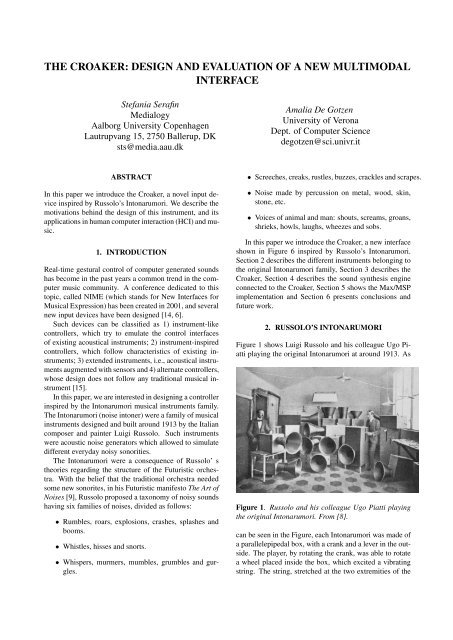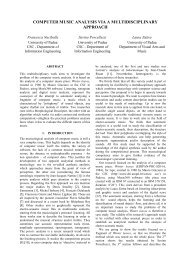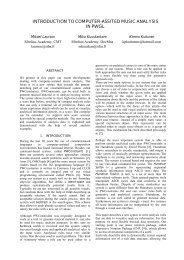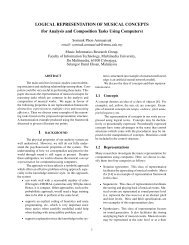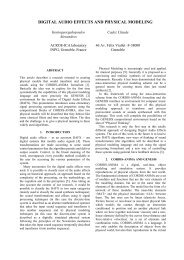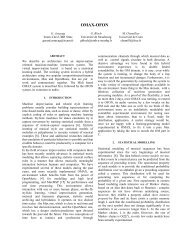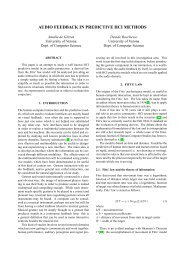the croaker: design and evaluation of a new multimodal interface
the croaker: design and evaluation of a new multimodal interface
the croaker: design and evaluation of a new multimodal interface
You also want an ePaper? Increase the reach of your titles
YUMPU automatically turns print PDFs into web optimized ePapers that Google loves.
THE CROAKER: DESIGN AND EVALUATION OF A NEW MULTIMODAL<br />
INTERFACE<br />
Stefania Serafin<br />
Medialogy<br />
Aalborg University Copenhagen<br />
Lautrupvang 15, 2750 Ballerup, DK<br />
sts@media.aau.dk<br />
Amalia De Gotzen<br />
University <strong>of</strong> Verona<br />
Dept. <strong>of</strong> Computer Science<br />
degotzen@sci.univr.it<br />
ABSTRACT<br />
In this paper we introduce <strong>the</strong> Croaker, a novel input device<br />
inspired by Russolo’s Intonarumori. We describe <strong>the</strong><br />
motivations behind <strong>the</strong> <strong>design</strong> <strong>of</strong> this instrument, <strong>and</strong> its<br />
applications in human computer interaction (HCI) <strong>and</strong> music.<br />
1. INTRODUCTION<br />
Real-time gestural control <strong>of</strong> computer generated sounds<br />
has become in <strong>the</strong> past years a common trend in <strong>the</strong> computer<br />
music community. A conference dedicated to this<br />
topic, called NIME (which st<strong>and</strong>s for New Interfaces for<br />
Musical Expression) has been created in 2001, <strong>and</strong> several<br />
<strong>new</strong> input devices have been <strong>design</strong>ed [14, 6].<br />
Such devices can be classified as 1) instrument-like<br />
controllers, which try to emulate <strong>the</strong> control <strong>interface</strong>s<br />
<strong>of</strong> existing acoustical instruments; 2) instrument-inspired<br />
controllers, which follow characteristics <strong>of</strong> existing instruments;<br />
3) extended instruments, i.e., acoustical instruments<br />
augmented with sensors <strong>and</strong> 4) alternate controllers,<br />
whose <strong>design</strong> does not follow any traditional musical instrument<br />
[15].<br />
In this paper, we are interested in <strong>design</strong>ing a controller<br />
inspired by <strong>the</strong> Intonarumori musical instruments family.<br />
The Intonarumori (noise intoner) were a family <strong>of</strong> musical<br />
instruments <strong>design</strong>ed <strong>and</strong> built around 1913 by <strong>the</strong> Italian<br />
composer <strong>and</strong> painter Luigi Russolo. Such instruments<br />
were acoustic noise generators which allowed to simulate<br />
different everyday noisy sonorities.<br />
The Intonarumori were a consequence <strong>of</strong> Russolo’ s<br />
<strong>the</strong>ories regarding <strong>the</strong> structure <strong>of</strong> <strong>the</strong> Futuristic orchestra.<br />
With <strong>the</strong> belief that <strong>the</strong> traditional orchestra needed<br />
some <strong>new</strong> sonorites, in his Futuristic manifesto The Art <strong>of</strong><br />
Noises [9], Russolo proposed a taxonomy <strong>of</strong> noisy sounds<br />
having six families <strong>of</strong> noises, divided as follows:<br />
• Rumbles, roars, explosions, crashes, splashes <strong>and</strong><br />
booms.<br />
• Whistles, hisses <strong>and</strong> snorts.<br />
• Whispers, murmers, mumbles, grumbles <strong>and</strong> gurgles.<br />
• Screeches, creaks, rustles, buzzes, crackles <strong>and</strong> scrapes.<br />
• Noise made by percussion on metal, wood, skin,<br />
stone, etc.<br />
• Voices <strong>of</strong> animal <strong>and</strong> man: shouts, screams, groans,<br />
shrieks, howls, laughs, wheezes <strong>and</strong> sobs.<br />
In this paper we introduce <strong>the</strong> Croaker, a <strong>new</strong> <strong>interface</strong><br />
shown in Figure 6 inspired by Russolo’s Intonarumori.<br />
Section 2 describes <strong>the</strong> different instruments belonging to<br />
<strong>the</strong> original Intonarumori family, Section 3 describes <strong>the</strong><br />
Croaker, Section 4 describes <strong>the</strong> sound syn<strong>the</strong>sis engine<br />
connected to <strong>the</strong> Croaker, Section 5 shows <strong>the</strong> Max/MSP<br />
implementation <strong>and</strong> Section 6 presents conclusions <strong>and</strong><br />
future work.<br />
2. RUSSOLO’S INTONARUMORI<br />
Figure 1 shows Luigi Russolo <strong>and</strong> his colleague Ugo Piatti<br />
playing <strong>the</strong> original Intonarumori at around 1913. As<br />
Figure 1. Russolo <strong>and</strong> his colleague Ugo Piatti playing<br />
<strong>the</strong> original Intonarumori. From [8].<br />
can be seen in <strong>the</strong> Figure, each Intonarumori was made <strong>of</strong><br />
a parallelepipedal box, with a crank <strong>and</strong> a lever in <strong>the</strong> outside.<br />
The player, by rotating <strong>the</strong> crank, was able to rotate<br />
a wheel placed inside <strong>the</strong> box, which excited a vibrating<br />
string. The string, stretched at <strong>the</strong> two extremities <strong>of</strong> <strong>the</strong>
ox, was attached to a vibrating drum connected to a radiating<br />
horn. By moving <strong>the</strong> lever back <strong>and</strong> forth, it was<br />
possible to change <strong>the</strong> tension <strong>and</strong> length <strong>of</strong> <strong>the</strong> vibrating<br />
string, <strong>and</strong> <strong>the</strong>refore its fundamental frequency.<br />
The 27 varieties <strong>of</strong> Intonarumori built by Russolo <strong>and</strong><br />
his colleagues aimed at reproducing such varieties <strong>of</strong> noises.<br />
The different names <strong>of</strong> <strong>the</strong> instruments were assigned according<br />
to <strong>the</strong> sound <strong>the</strong>y produced. As an example, in<br />
<strong>the</strong> Gracidatore (<strong>the</strong> Croaker), whose excitation mechanism<br />
is shown in Figure 2, <strong>the</strong> shape <strong>of</strong> <strong>the</strong> rotating wheel<br />
allows to obtain plucked string sonorities. The wheel, rotating<br />
at a speed controlled by an external crank, excites a<br />
vibrating string attached at two extremities <strong>of</strong> <strong>the</strong> wooden<br />
soundbox. The player, as in <strong>the</strong> o<strong>the</strong>r instruments, is able<br />
to control <strong>the</strong> tension <strong>of</strong> <strong>the</strong> string by using an external<br />
lever.<br />
Amplitude<br />
1<br />
0.8<br />
0.6<br />
0.4<br />
0.2<br />
0<br />
−0.2<br />
RADIATING HORN<br />
LEVER 1 LEVER 2<br />
−0.4<br />
−0.6<br />
−0.8<br />
−1<br />
0 0.5 1 1.5 2 2.5 3 3.5 4 4.5<br />
Time (samples)<br />
x 10 4<br />
Amplitude<br />
VIBRATING STRING<br />
1<br />
0.8<br />
0.6<br />
0.4<br />
0.2<br />
0<br />
−0.2<br />
−0.4<br />
−0.6<br />
−0.8<br />
EXCITATION MECHANISM<br />
−1<br />
0 0.5 1 1.5 2 2.5 3 3.5 4 4.5<br />
Time (samples)<br />
x 10 4<br />
Figure 2. The excitation mechanism <strong>of</strong> <strong>the</strong> Gracidatore<br />
(top) <strong>and</strong> a time domain waveform for one second <strong>of</strong><br />
sound (bottom).<br />
In <strong>the</strong> Crepitatore (<strong>the</strong> Cracker), show in Figure 3, <strong>the</strong><br />
excitation mechanism is a metal wheel, <strong>and</strong> two levers are<br />
present, as well as two vibrating strings. This allowed <strong>the</strong><br />
string attached to <strong>the</strong> drumskin to be different from <strong>the</strong><br />
one excited by <strong>the</strong> rotating wheel. The same idea was also<br />
adopted in <strong>the</strong> Stroppicciatore (<strong>the</strong> Rubber). Documents<br />
<strong>and</strong> patents did not succeed in explaining <strong>the</strong> role <strong>of</strong> <strong>the</strong><br />
two strings in <strong>the</strong> resulting sonorities produced by <strong>the</strong> instruments.<br />
In <strong>the</strong> Ululatore (Howler), described by Russolo as ”s<strong>of</strong>t,<br />
velvety <strong>and</strong> delicate”, shown in Figure 4, <strong>the</strong> excitation<br />
mechanism was a metal wheel.<br />
Russolo <strong>and</strong> his assistant Ugo Piatti researched all <strong>the</strong><br />
physical aspects that could be varied to obtain different<br />
timbres <strong>and</strong> sonorities, in order to achieve a satisfactory<br />
simulation <strong>of</strong> <strong>the</strong> families <strong>of</strong> noises described above.<br />
As an example, <strong>the</strong> string was made <strong>of</strong> ei<strong>the</strong>r steel or<br />
gut, <strong>the</strong> wheel was made <strong>of</strong> metal or wood, with its rim<br />
Figure 3. Reproduction <strong>of</strong> <strong>the</strong> Crepitatore (top). In this<br />
instrument, two levers are present. Bottom: time domain<br />
waveform obtained by playing <strong>the</strong> instrument for one second.<br />
Notice <strong>the</strong> noisy waveform.<br />
notched with small teeth or smoo<strong>the</strong>r, <strong>and</strong> <strong>the</strong> skins were<br />
soaked in a variety <strong>of</strong> special chemical preparations. Fur<strong>the</strong>rmore,<br />
<strong>the</strong> pressure <strong>of</strong> <strong>the</strong> wheel against <strong>the</strong> string, stronger<br />
than is necessary with a violin bow, created a louder <strong>and</strong><br />
noisier sound quality.<br />
Russolo also experimented with more radical Intonarumori,<br />
based on electrical ra<strong>the</strong>r than mechanical control,<br />
such as <strong>the</strong> one used in <strong>the</strong> Hummer (Ronzatore), which<br />
was more a percussion than a string instrument. It has<br />
been suggested that <strong>the</strong> electrical control might have been<br />
due to <strong>the</strong> need for a speed that was too rapid to have been<br />
achieved manually. As a supplementary enhancement, a<br />
second lever was added in <strong>the</strong> Burster (Scoppiatore), <strong>the</strong><br />
Whistler (Sibilatore) <strong>and</strong> <strong>the</strong> Gurgler (Gorgogliatore). In<br />
his writings, Russolo does not explain <strong>the</strong> need for such<br />
second lever.<br />
During World War II, all <strong>the</strong> original Intonarumori got<br />
destroyed. Since <strong>the</strong>n, several attempts to rebuild such instruments<br />
were made. Among <strong>the</strong>m, <strong>the</strong> ones shown in<br />
Figure 5 are some reproductions displayed at <strong>the</strong> exposition<br />
Sounds <strong>and</strong> Lights at <strong>the</strong> Pompidou Center in Paris in<br />
December 2004.<br />
3. THE CROAKER<br />
In <strong>the</strong> attempt to create a modern reconstruction <strong>of</strong> Russolo’s<br />
Intonarumori, which could be used both as a musical<br />
instrument on its own <strong>and</strong> as an <strong>interface</strong> for real-time<br />
audio-visual syn<strong>the</strong>sis, we <strong>design</strong>ed <strong>the</strong> Croaker, shown in<br />
Figure 6.<br />
In its first prototype, <strong>the</strong> Croaker is an <strong>interface</strong> built<br />
with Lego blocks. The name <strong>of</strong> <strong>the</strong> instrument derives<br />
from one <strong>of</strong> <strong>the</strong> original Russolo’s instruments.
EXCITATION MECHANISM<br />
VIBRATING STRING<br />
1<br />
0.8<br />
0.6<br />
Amplitude<br />
0.4<br />
0.2<br />
0<br />
−0.2<br />
−0.4<br />
−0.6<br />
−0.8<br />
−1<br />
0 0.5 1 1.5 2 2.5 3 3.5 4 4.5<br />
Time (samples)<br />
x 10 4<br />
Figure 5. Different Intonarumori as shown in <strong>the</strong> exposition<br />
Sounds <strong>and</strong> Lights, Paris, Pompidou Center, December<br />
2004.<br />
Figure 4. The excitation mechanism <strong>of</strong> <strong>the</strong> Ululatore<br />
(top), <strong>and</strong> a one second time domain waveform (bottom).<br />
As in <strong>the</strong> original Intonarumori, <strong>the</strong> Croaker is provided<br />
with a one degree <strong>of</strong> freedom lever moving vertically,<br />
<strong>and</strong> a rotating crank. The position <strong>of</strong> <strong>the</strong> lever is detected<br />
by a potentiometer, attached as shown in Figure 7.<br />
The rotation <strong>of</strong> <strong>the</strong> crank is also sensed by a different potentiometer,<br />
attached to <strong>the</strong> wheel as shown in Figure 7.<br />
Both sensors send a continuous stream <strong>of</strong> data. The current<br />
prototype <strong>of</strong> <strong>the</strong> Croaker is shown in Figure 8. Compared<br />
to <strong>the</strong> one shown in Figure 6, <strong>the</strong> instrument has a<br />
more compact shape, <strong>and</strong> a linear slider is provided. Such<br />
slider allows to vary <strong>the</strong> pitch range <strong>of</strong> <strong>the</strong> instrument.<br />
The variables sensed by <strong>the</strong> current prototype <strong>of</strong> <strong>the</strong><br />
Croaker are illustrated in Figure 9 [5]. The three circles<br />
in Figure 9 represent <strong>the</strong> rotational position sensed by <strong>the</strong><br />
potentiometer connected to <strong>the</strong> lever <strong>and</strong> <strong>the</strong> rotational position<br />
sensed by <strong>the</strong> potentiometer connected to <strong>the</strong> crank.<br />
Moreover, a continuous slider is added. Since both <strong>the</strong> potentiometer<br />
<strong>and</strong> <strong>the</strong> lever connected to <strong>the</strong> slider are controlling<br />
<strong>the</strong> fundamental frequency <strong>of</strong> <strong>the</strong> instrument, <strong>the</strong>y<br />
are connected by a solid black line.<br />
The sensors are attached to a Teleo microprocessor manifactured<br />
by Making Things. 1 The microprocessor is connected<br />
to a computer through <strong>the</strong> USB port.<br />
By using <strong>the</strong> Max/MSP <strong>and</strong> Jitter s<strong>of</strong>tware, 2 some adhoc<br />
external objects have been developed which convert<br />
<strong>the</strong> data sent by <strong>the</strong> sensors into numerical input which<br />
can be read by Max. Such data are used as controllers to<br />
several audio-visual simulations, as described in <strong>the</strong> following<br />
section.<br />
The Croaker is an <strong>interface</strong> which is easy to learn how<br />
to play. It is played by controlling <strong>the</strong> position <strong>of</strong> <strong>the</strong> lever<br />
with <strong>the</strong> left h<strong>and</strong>, while rotating <strong>the</strong> crank with <strong>the</strong> right<br />
h<strong>and</strong>. It is also possible to vary <strong>the</strong> pitch range <strong>of</strong> <strong>the</strong><br />
1 www.makingthings.com<br />
2 www.cycling74.com<br />
Figure 6. The first prototype <strong>of</strong> <strong>the</strong> Croaker: a <strong>new</strong> <strong>interface</strong><br />
inspired by Russolo’s Intonarumori.<br />
instrument by using <strong>the</strong> linear slider.<br />
4. THE SOUND SYNTHESIS ENGINE<br />
The Croaker is a controller which can drive several sound<br />
syn<strong>the</strong>sis algorithms. We developed a physical model <strong>of</strong><br />
two kinds <strong>of</strong> Intonarumori, <strong>the</strong> Croaker <strong>and</strong> <strong>the</strong> Howler,<br />
based on a plucked <strong>and</strong> rubbed excitation mechanism respectively.<br />
The physical model <strong>of</strong> such instruments is based on<br />
previous research on waveguide string models with tension<br />
modulation [12], transient <strong>and</strong> sustained excitations<br />
mechanisms.<br />
Given <strong>the</strong> lack <strong>of</strong> availability <strong>of</strong> a physical Intonarumori,<br />
<strong>the</strong> parameters <strong>of</strong> <strong>the</strong> different components <strong>of</strong> <strong>the</strong><br />
model are not derived from analysis <strong>of</strong> <strong>the</strong> instruments,<br />
but by empirically adjusting <strong>the</strong> parameters <strong>of</strong> <strong>the</strong> physical<br />
model.
Linear<br />
Rotary<br />
X Y Z rX rY rZ<br />
Delta force Force Movement Position<br />
SLIDER<br />
LEVER<br />
CRANK<br />
Angle Delta angle Torque Delta torque<br />
1 10 100 Inf 1 10 100 Inf 1 10 100 Inf 1 10 100 Inf 1 10 100 Inf 1 10 100 Inf<br />
Measure<br />
Figure 9. Types <strong>of</strong> variables sensed <strong>and</strong> resolution <strong>of</strong> <strong>the</strong><br />
Croaker. From [5].<br />
following.<br />
Figure 7.<br />
Croaker.<br />
CRANK<br />
Placement <strong>of</strong> <strong>the</strong> two potentiometers in <strong>the</strong><br />
LEVER<br />
SLIDER<br />
Figure 8. The current prototype <strong>of</strong> <strong>the</strong> Croaker.<br />
4.1. Modeling <strong>the</strong> vibrating string<br />
The approach to simulation relies on <strong>the</strong> decomposition <strong>of</strong><br />
a vibrating system into excitation <strong>and</strong> resonator. The exciting<br />
object is modeled as a lumped mechanical system,<br />
using a modal description, while <strong>the</strong> string is modeled using<br />
a one dimensional waveguide [10]. Losses along <strong>the</strong><br />
string <strong>and</strong> at <strong>the</strong> extremities are lumped into a low-pass<br />
filter. In order to allow to continuously vary <strong>the</strong> fundamental<br />
frequency <strong>of</strong> <strong>the</strong> string, <strong>the</strong> tension modulation algorithm<br />
proposed in [12] was implemented. Such effect is<br />
obtained by using a time-varying fractional delay filter, as<br />
shown in [13].<br />
Different string’s properties were simulated by using<br />
allpass filters, added in cascade to <strong>the</strong> string loop. The<br />
string is excited by ei<strong>the</strong>r a transient excitation (such as in<br />
<strong>the</strong> case <strong>of</strong> <strong>the</strong> Gracidatore) or a sustained excitation (like<br />
in <strong>the</strong> Crepidatore). Such mechanisms are described in <strong>the</strong><br />
4.2. Modeling <strong>the</strong> excitation mechanism<br />
4.2.1. Transient excitation<br />
In order to simulate a transient excitation between <strong>the</strong> vibrating<br />
wheel <strong>and</strong> <strong>the</strong> string, a model <strong>of</strong> a plucked excitation<br />
mechanism such as <strong>the</strong> ones proposed in [10] is<br />
adopted. The transient excitation in <strong>the</strong> Intonarumori is<br />
perceived as a highly inharmonic plucked string, <strong>and</strong> <strong>the</strong><br />
frequency <strong>of</strong> plucking is given by <strong>the</strong> rotational speed <strong>of</strong><br />
<strong>the</strong> wheel divided by <strong>the</strong> number <strong>of</strong> bumps present in <strong>the</strong><br />
wheel itself.<br />
4.2.2. Sustained excitation<br />
To model <strong>the</strong> sustained excitation between <strong>the</strong> rotating<br />
wheel <strong>and</strong> <strong>the</strong> string, <strong>the</strong> elasto-plastic friction model proposed<br />
in [3], <strong>and</strong> already adopted for sound syn<strong>the</strong>sis purposes<br />
in [1], is used. The idea behind this modeling approach<br />
is that at contact point objects exhibit a r<strong>and</strong>om<br />
bristle behavior, captured <strong>and</strong> averaged in a single-state<br />
system. Applying a tangential force affects <strong>the</strong> average<br />
bristle deflection <strong>and</strong>, if <strong>the</strong> deflection is large enough, <strong>the</strong><br />
bristles start to slip. The class <strong>of</strong> elasto-plastic models<br />
proposed by Dupont <strong>and</strong> colleagues can be described by<br />
<strong>the</strong> equations<br />
[<br />
]<br />
z<br />
ż = f NL (v, z)v 1 − α(z, v)<br />
z ss (v)<br />
, ż = v − |v|<br />
g(v) z ,<br />
(1)<br />
f f = σ 0 z + σ 1 ż + σ 2 v, (2)<br />
where z is <strong>the</strong> average bristle deflection, v is <strong>the</strong> relative<br />
velocity between <strong>the</strong> two surfaces, σ 0 is <strong>the</strong> stiffness <strong>of</strong> <strong>the</strong><br />
bristles, σ 1 is <strong>the</strong> bristle damping, σ 2 v accounts for linear<br />
viscous friction, <strong>and</strong> f f is <strong>the</strong> resulting friction force.<br />
The auxiliary functions α <strong>and</strong> z ss can be parametrized<br />
in various ways. Here we follow [3] by defining z ss as<br />
z ss (v) = sgn(v)<br />
σ 0<br />
[<br />
f c + (f s − f c )e −(v/vs)2] , (3)
where f c , f s , are <strong>the</strong> Coulomb force <strong>and</strong> <strong>the</strong> friction force<br />
respectively, <strong>and</strong> v s is <strong>the</strong> Stribeck velocity (<strong>the</strong> subscript<br />
ss in z ss st<strong>and</strong>s for “steady-state”). As far as α is concerned,<br />
we follow [3] by defining it as<br />
⎧<br />
⎫<br />
0 |z| < z ba ⎬<br />
⎪⎨<br />
α<br />
α(v, z) = m (v, z) z ba < |z| < z ss (v)<br />
⎭ .<br />
1 |z| > z ss (v)<br />
⎪⎩<br />
0 if sgn(v) ≠ sgn(z)<br />
(4)<br />
The function α m (v, z), which describes <strong>the</strong> transition between<br />
elastic <strong>and</strong> plastic behavior, is parametrized as<br />
[<br />
1 + sin<br />
(<br />
π z − 1 2 (z )]<br />
ss(v) + z ba )<br />
z ss (v) − z ba<br />
α m (v, z) = 1 2<br />
(5)<br />
Therefore <strong>the</strong> parameter z ba defines <strong>the</strong> point where α<br />
starts to take non-zero values, <strong>and</strong> is termed breakaway<br />
displacement.<br />
In order to account for irregularities <strong>of</strong> <strong>the</strong> rotating wheel,<br />
fractal noise was added to <strong>the</strong> friction function <strong>of</strong> Eq.2.<br />
.<br />
<strong>of</strong> <strong>the</strong> sustained excitation, <strong>the</strong> velocity affects <strong>the</strong> exciter<br />
velocity. As is <strong>the</strong> case in <strong>the</strong> original instruments, <strong>the</strong> excitation<br />
force cannot be controlled by <strong>the</strong> player, but it is<br />
predefined in <strong>the</strong> physical model. Similarly, <strong>the</strong> parameters<br />
<strong>of</strong> <strong>the</strong> friction model, as well as <strong>the</strong> inharmonicity <strong>of</strong><br />
<strong>the</strong> string, are predefined, <strong>and</strong> allow to simulate different<br />
instruments from <strong>the</strong> Intonarumori family.<br />
6. SIMULATION RESULTS<br />
As an example, we created a physical model <strong>of</strong> <strong>the</strong> Ululatore,<br />
instrument in which a sustained excitation is present.<br />
Figure 11 shows <strong>the</strong> spectrogram <strong>of</strong> <strong>the</strong> Ululatore, when<br />
<strong>the</strong> tension parameters is varied. Notice <strong>the</strong> effect <strong>of</strong> tension<br />
modulation in <strong>the</strong> resulting spectrum.<br />
4.3. Modeling <strong>the</strong> drum-skin<br />
In <strong>the</strong> original Intonarumori, <strong>the</strong> vibrating string excites<br />
a drumskin. The vibration <strong>of</strong> <strong>the</strong> drumskin strongly contributes<br />
to <strong>the</strong> timbre <strong>of</strong> <strong>the</strong> instruments. In order to simulate<br />
<strong>the</strong> drumskin, we <strong>design</strong>ed a 2D waveguide mesh, as<br />
proposed in [11].<br />
5. IMPLEMENTATION<br />
The Intonarumori model has been implemented as an extension<br />
to <strong>the</strong> Max/MSP environment. 3 In <strong>the</strong> Intonarumori<br />
originally <strong>design</strong>ed by Russolo, <strong>the</strong> control parameters<br />
<strong>of</strong> <strong>the</strong> instruments are <strong>the</strong> type <strong>of</strong> excitation mechanism<br />
(plucked or rubbed), which corresponds to <strong>the</strong> simulation<br />
<strong>of</strong> different instruments <strong>of</strong> <strong>the</strong> family, <strong>the</strong> rotational<br />
velocity <strong>of</strong> <strong>the</strong> excitation wheel, controlled by <strong>the</strong> player<br />
through <strong>the</strong> external crank, <strong>and</strong> <strong>the</strong> string tension, controlled<br />
by <strong>the</strong> player by moving <strong>the</strong> lever on top <strong>of</strong> <strong>the</strong><br />
instrument. Additionally, it is possible to control <strong>the</strong> frequency<br />
range <strong>of</strong> <strong>the</strong> vibrating string by using a continuous<br />
linear slider. Figure 10 shows <strong>the</strong> Max/MSP patch<br />
which simulates <strong>the</strong> Ululatore. In this patch, it is possible<br />
to identify three main components. The top part contains<br />
<strong>the</strong> objects which implement <strong>the</strong> connection between <strong>the</strong><br />
Teleo sensors board <strong>and</strong> Max/MSP. These objects are already<br />
available from <strong>the</strong> Teleo website. The central part<br />
contains <strong>the</strong> mapping strategies to connect <strong>the</strong> data <strong>of</strong> <strong>the</strong><br />
sensors to <strong>the</strong> sound syn<strong>the</strong>sis engine. The position <strong>of</strong> <strong>the</strong><br />
lever is mapped linearly to <strong>the</strong> fundamental frequency <strong>of</strong><br />
<strong>the</strong> string. The fundamental frequency <strong>of</strong> <strong>the</strong> string can<br />
also be varied by using <strong>the</strong> linear slider. The rotational<br />
velocity <strong>of</strong> <strong>the</strong> crank is obtained by calculating <strong>the</strong> derivative<br />
<strong>of</strong> <strong>the</strong> position, <strong>and</strong> mapped to <strong>the</strong> excitation velocity.<br />
In <strong>the</strong> case <strong>of</strong> a transient excitation, <strong>the</strong> excitation velocity<br />
affects <strong>the</strong> number <strong>of</strong> bumps per second. In <strong>the</strong> case<br />
3 www.cycling74.com<br />
Figure 11. Spectrum <strong>of</strong> <strong>the</strong> simulated Ululatore. Notice<br />
<strong>the</strong> effect <strong>of</strong> tension modulation.<br />
7. CONCLUSION<br />
In this paper we introduced <strong>the</strong> Croaker, a <strong>new</strong> input <strong>interface</strong><br />
inspired by Luigi Russolos Intonarumori. We are<br />
currently experimenting with <strong>the</strong> Croaker as a controller<br />
for HCI experiments. We are examining <strong>the</strong> potentials<br />
<strong>of</strong> <strong>the</strong> Croaker as a <strong>new</strong> input device, <strong>and</strong> we are studying<br />
different mapping strategies. We are also <strong>design</strong>ing a<br />
more compact version <strong>of</strong> <strong>the</strong> instrument, in which <strong>the</strong> mechanical<br />
devices <strong>and</strong> sensors remain <strong>the</strong> same, but <strong>the</strong> size<br />
<strong>and</strong> shape <strong>of</strong> <strong>the</strong> instrument is better defined. We are also<br />
adding a soundbox <strong>and</strong> a radiating horn to <strong>the</strong> <strong>interface</strong>,<br />
in order to obtain a more faithful reproduction <strong>of</strong> Russolos<br />
original instrument.<br />
8. REFERENCES<br />
[1] F. Avanzini, S. Serafin, D. Rocchesso. Modeling Interactions<br />
between Rubbed Dry Surfaces Using an<br />
Elasto-Plastic Friction Model. Proc. DAFX 2002,<br />
Hamburg, Germany.
Figure 10. The Max/MSP patch which simulates <strong>the</strong> Intonarumori physical model. On <strong>the</strong> top part <strong>of</strong> <strong>the</strong> patch <strong>the</strong>re<br />
are <strong>the</strong> instructions to ga<strong>the</strong>r data from <strong>the</strong> three sensors. In <strong>the</strong> central part <strong>the</strong> mapping between <strong>the</strong> sensors <strong>and</strong> <strong>the</strong><br />
physical model is implemented. In <strong>the</strong> bottom part, <strong>the</strong> external objects simulate <strong>the</strong> intronarumori interaction between<br />
<strong>the</strong> excitation <strong>and</strong> <strong>the</strong> string, as well as <strong>the</strong> drumskin.<br />
[2] F. Avanzini <strong>and</strong> D. Rocchesso, Modeling Collision<br />
Sounds: Non-linear Contact Force, Proc. COST-G6<br />
Conf. Digital Audio Effects (DAFx-01), Limerick,<br />
2001, pp. 61-66.<br />
[3] P. Dupont, V. Hayward, B. Armstrong <strong>and</strong> F. Altpeter<br />
(2002). ”Single State Elasto-Plastic Friction<br />
Models,” IEEE Transactions on Automatic Control,<br />
Vol. 47, No. 5, pp. 787-792.<br />
[4] G. Borin, G. De Poli <strong>and</strong> D. Rocchesso. Elimination<br />
<strong>of</strong> delay-free loops in discrete-time models <strong>of</strong><br />
nonlinear acoustic systems. Speech <strong>and</strong> Audio Processing,<br />
IEEE Transactions on ,Volume: 8 , Issue: 5<br />
, Sept. 2000 Pages:597 - 605<br />
[5] Card, S.K, Mackinlay, D. <strong>and</strong> Robertson, G.G. A<br />
Morphological Analysis <strong>of</strong> <strong>the</strong> Design Space <strong>of</strong> Input<br />
Devices. ACM Transactions on Information Systems,<br />
Vol. 9, No. 2, April 1991, Pages 99-122.<br />
[6] Cook, P. Principles for Designing Computer Music<br />
Controllers. Proc. CHI 2001.<br />
[7] Laakso, T. I., Valimaki, V., Karjalainen, M., <strong>and</strong><br />
Laine, U. K. 1996. Splitting <strong>the</strong> unit delay-tools for<br />
fractional delay filter <strong>design</strong>. IEEE Signal Processing<br />
Magazine, vol. 13, no. 1, pp. 30-60.<br />
[8] Maffina. G. Luigi Russolo e l’Arte dei rumori, con<br />
tutti gli scritti musicali. Torino: Martano editore,<br />
1978.<br />
[9] Russolo, L. L’arte dei rumori (The Art <strong>of</strong> Noise).<br />
Edizioni Futuriste di Poesia, 1916.<br />
[10] Smith, Julius O. Physical Audio Signal Processing:<br />
Digital Waveguide Modeling <strong>of</strong> Musical Instruments<br />
<strong>and</strong> Audio Effects, August 2004 Draft, Center<br />
for Computer Research in Music <strong>and</strong> Acoustics<br />
(CCRMA), Stanford University.<br />
[11] S. Van Duyne <strong>and</strong> J.O. Smith. Physical modeling<br />
with <strong>the</strong> 2D waveguide mesh. In Proc. Int. Computer<br />
Music Conf. (ICMC’93), pages 40–47.<br />
[12] V. Valimaki <strong>and</strong> T. Tolonen <strong>and</strong> M. Karjalainen.<br />
Plucked-string syn<strong>the</strong>sis algorithms with tension
modulation nonlinearity. IEEE International Conference<br />
on Acoustics, Speech <strong>and</strong> Signal Processing,<br />
Phoenix, Arizona, March 1999.<br />
[13] V. Valimaki, T. Tolonen, <strong>and</strong> M. Karjalainen. Signal<br />
dependent nonlinearities for physical models<br />
timevarying fractional delay filters. Proc. Int. Music<br />
Conf., Ann Arbor, MI, Oct. 1998.<br />
[14] W<strong>and</strong>erley, M. <strong>and</strong> Battier, M. (eds). Trends in Gestural<br />
Control <strong>of</strong> Music. Ircam - Ircam, Centre Pompidou,<br />
2000.<br />
[15] W<strong>and</strong>erley, M. <strong>and</strong> Orio, N. Evaluation <strong>of</strong> Input Devices<br />
for Musical Expression: Borrowing tools from<br />
HCI. Computer Music Journal, 26:3, 2003.<br />
[16] S. Serafin, J.O. Smith III <strong>and</strong> J. Woodhouse. An<br />
investigation <strong>of</strong> <strong>the</strong> impact <strong>of</strong> torsion waves <strong>and</strong><br />
friction characteristics on <strong>the</strong> playability <strong>of</strong> virtual<br />
bowed strings. Proc. IEEE WASPAA, 1999.


